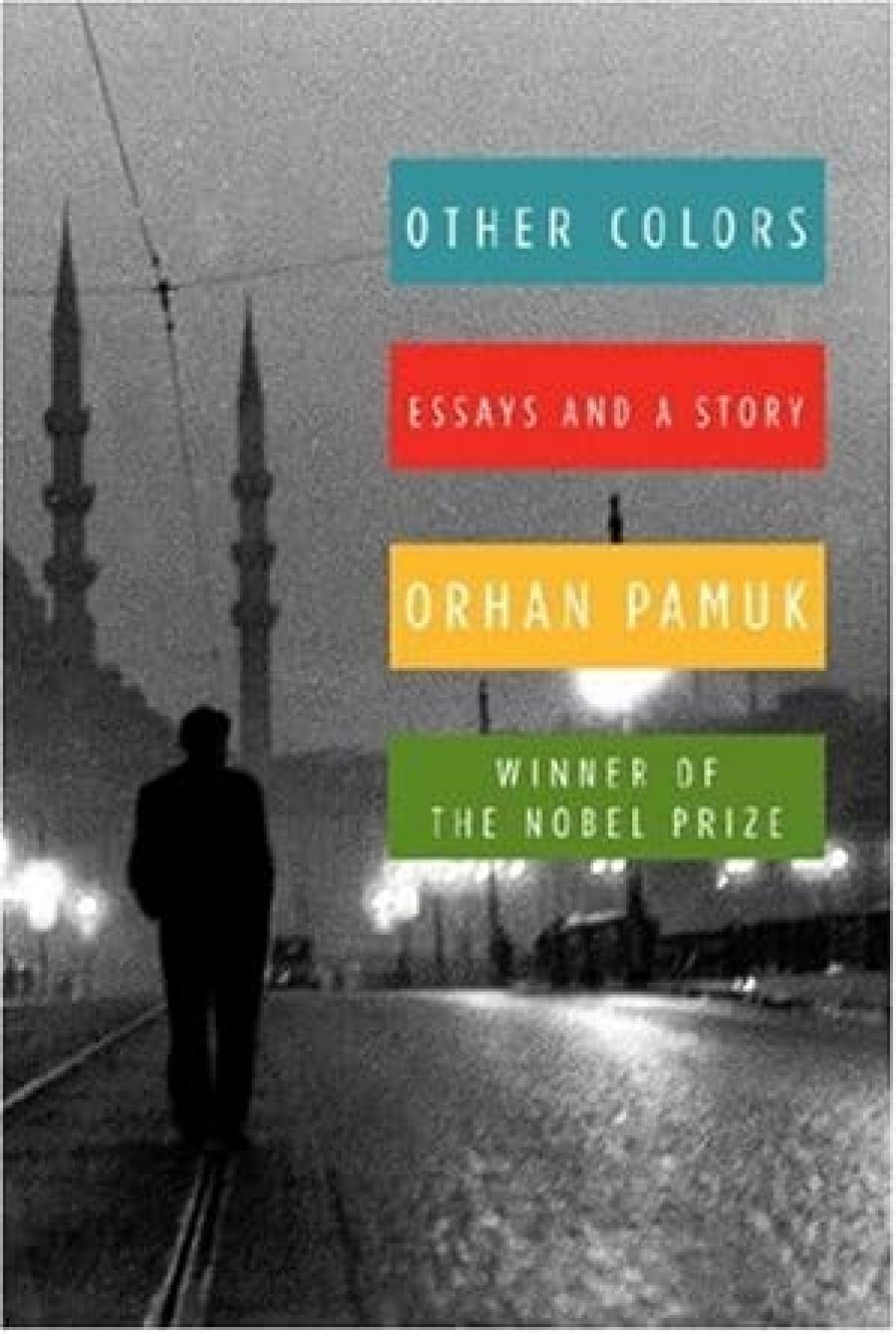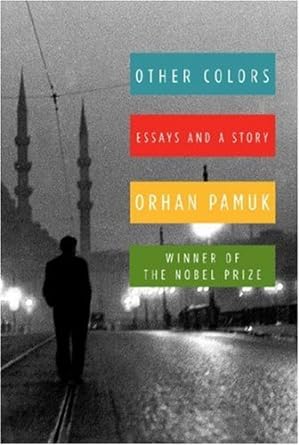
- Free Article: No
- Custom Article Title: The graphomaniac
- Review Article: Yes
- Article Title: The graphomaniac
- Online Only: No
- Custom Highlight Text:
Media discussion of the 2006 Nobel Prize winner, Orhan Pamuk, tends to focus on his political persecution at the hands of the Turkish state. Pamuk concedes that history has forced him to don a ‘political persona’, one that journalists and literary festival audiences are keen to encounter. Yet Pamuk’s new collection of essays, Other Colours: Essays and a Story, reveals where politics (or political commentary) and the writer of imaginative thinking part company.
- Book 1 Title: Other Colours
- Book 1 Subtitle: Essays and a Story
- Book 1 Biblio: Faber, $45 hb, 433 pp
- Book 1 Cover Small (400 x 600):

- Book 1 Cover (800 x 1200):

The strictly political content of Other Colours is straightforward: the Turkish public needs to take responsibility for its government’s repression of human rights; allowing Turkey to join the European Union would help improve relations between Muslim nations and the West; and ‘this savage, cruel war’ in Iraq has disastrously undermined those struggling for secularism and democracy in the Middle East.
The real interest of Other Colours cannot be so easily summarised. Drawn from the past twenty-five years, these essays and interviews on subjects as varied as barber shops, earthquakes, Islamic miniatures and Thomas Bernhard demonstrate what is particular to the novelist’s way of looking at and writing about the world.
It is a way of thinking that builds from an attentiveness to the shape of objects and experiences, with Pamuk’s receptivity to the physical world summarised in the title of one essay, ‘When the Furniture is Talking, How Can You Sleep?’. Thought progresses via suggestion and association, rather than through deductive logic, as when a hair-raising taxi ride in Tehran leads to a meditation on the subtler forms of anti-Western nationalism. Subjects interconnect in surprising ways, with every kind of experience open to wider resonance. In one of his most evocative essays, ‘Frankfurter’, Pamuk’s adolescent conversion to the solitary pleasure of street food is a means of exploring what it is to be modern. The mood of such writing is personal, ruminative, melancholic and elegiac, obsessed with ‘all those people and places that are gone forever’.
Perhaps most significantly, there is a willingness for arguments to remain open and unresolved. Pamuk’s favouring of numbered points over careful paragraphing keeps his ideas energised, allowing for provocation and contradiction. Novelists, after all, are schooled in entertaining competing opinions, a quality that Pamuk contrasts with ‘the monistic outlook’ of politics.
It is fitting that the preface to Other Colours invokes Virginia Woolf. As her essays helped invent this kind of writing; while among contemporary novelists there are similarities with Milan Kundera’s non-fiction, though Pamuk’s is more impressionistic and less intellectually nuanced.
Pamuk writes that ‘the history of the novel is a history of human liberation.’ The novel’s imaginative play with other identities offers the reader liberating insight into the deepest ideas governing the creation of their social and political selves; including ‘shocking discoveries’ such as Dostoevsky’s view that it is possible to love degradation, or destabilising ones such as Lawrence Sterne’s that our life spirals without a centre. Pamuk’s own contribution to this tradition of novelistic discovery (which Kundera has argued is as significant as the history of scientific discovery) centres on shame. Kafka is, of course, the great modern master of this emotion, but whereas Kafka’s work explores shame and the family, Pamuk investigates the relationship of shame and country.
From the reformist sultans of the late eighteenth century through to Atatürk’s modernising legislation in the 1920’s, Turkish society has looked to the West as a model of progress and perfection. Against this ‘dream of Europe’, Turkish reality inevitably falls short, leaving its citizens prone to deep experiences of anxiety and humiliation, the permutations of which Pamuk traces throughout Other Colours:
The Westernizer is ashamed first and foremost of not being European. Sometimes (not always) he is ashamed of what he does to become European. He is ashamed that he has lost his identity in his struggle to become European. He is ashamed of who is and who is he not. He is ashamed of the shame itself; sometimes he rails against it and sometimes he accepts it with resignation. He is ashamed and angry when his shame is exposed.
Fittingly, the most resonant meditation on shame in Other Colours appears in a Kafkaesque fable of a man’s fraught reaction to passing a ‘No Entry’ sign on the street. Yet, as is acknowledged in this essay reflection on the psychology of shame and its relation to other emotions, notably rage, ‘is not the sort of thinking that comes easily’.
What comes more easily is political sloganeering. Visiting Germany, Pamuk meets expatriate Turks who passionately debate their legal status; beneath their arguments, Pamuk hears ‘fears of humiliation, unfulfilled desires, pain, and isolation’, unlikely to be neatly resolved by the granting of a passport. Although the stalled negotiations over membership of the European Union provoke criticisms of European hypocrisy among the Turkish bourgeoisie, Pamuk argues that their anger is the latest chapter in the long history of ‘seeing that for all our efforts to be Western, they still don’t want us’.
Shame is a profoundly uncomfortable emotion, and it is not only its sufferers who seek to escape it with other, more malleable, explanations. Western commentators ignore ‘the spiritual lives of the poor, humiliated, discredited peoples’ in their analyses of terrorism, preferring factors more easily quantified and amenable to the language of editorials. It has been widely debated whether sympathy for the 9/11 hijackers is the result of ideology (Islam) or social factors (poverty). Pamuk argues that its deeper source is this same cultural shame: ‘the crushing humiliation felt throughout the Third World.’ To respond to this emotional reality, as the West has done, with military incursions and visa restrictions merely accentuates its root cause.
Pamuk aligns his own powerfully ambivalent relationship to the West with Dostoevsky’s, a novelist to whom Other Colours repeatedly returns. Although their writing is very different, Pamuk’s characterised by a self-effacing and meandering lyricism in place of Dostoevsky’s enraged intensity, the two men have much in common: living at the edges of Europe, in cultures convulsed by ideas about ‘Westernisation’, while committed to a uniquely Western art form.
As in his wonderful Istanbul: Memories of a City (2005), Pamuk’s musings on nationhood are inseparable from autobiography, and the essays in Other Colours combine to make a picture of the artist – solitary, stubborn, diligent, whimsical, obsessive. Istanbul, a city enamoured with decay and ennui, is his natural habitat.
What defines this man more than any other quality is his ‘writing sickness’: ‘I have always believed there to be a greedy and almost implacable graphomaniac inside me – a creature who can never write enough, who is for ever setting life in words – and that to make him happy I need to keep writing.’ Other Colours returns to the demands of this sickness and its rewards. Pamuk muses that, even more than writing, what he is addicted to is what the writing requires – being alone in a room with one’s thoughts.
This, also, is why we read. It is a happiness imperilled in a world ‘full of things that conspire to keep a person from literature’. But for those of us left unsatisfied by political commentary, and dispirited by the superficial drone of electioneering, Other Colours is a reminder that the novelist offers another way of seeing the world .


Comments powered by CComment